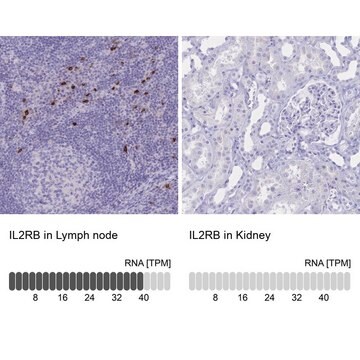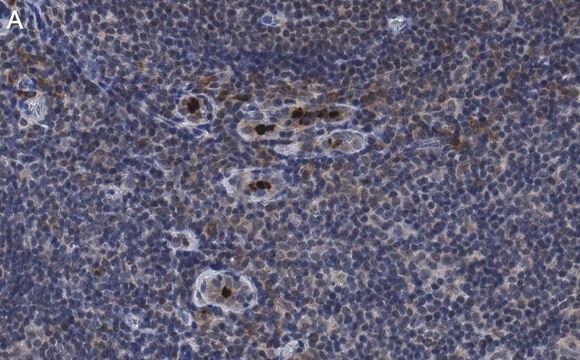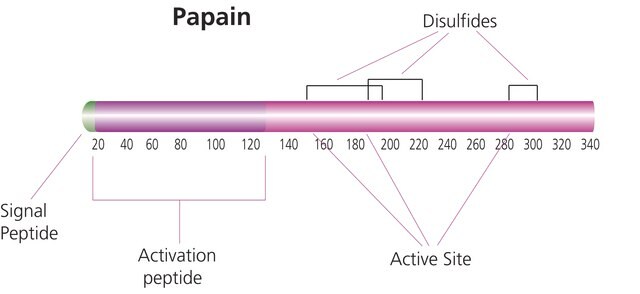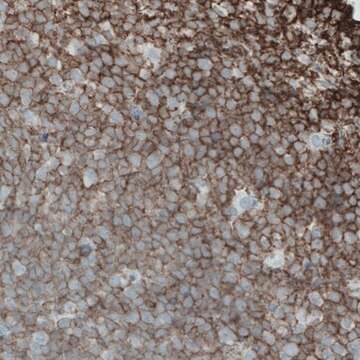推荐产品
生物源
mouse
品質等級
100
500
共軛
unconjugated
抗體表格
culture supernatant
抗體產品種類
primary antibodies
無性繁殖
NAT105, monoclonal
描述
For In Vitro Diagnostic Use in Select Regions (See Chart)
形狀
buffered aqueous solution
物種活性
human
包裝
vial of 0.1 mL concentrate (315M-94)
vial of 0.5 mL concentrate (315M-95)
bottle of 1.0 mL predilute (315M-97)
vial of 1.0 mL concentrate (315M-96)
bottle of 7.0 mL predilute (315M-98)
製造商/商標名
Cell Marque™
技術
immunohistochemistry (formalin-fixed, paraffin-embedded sections): 1:25-1:100
同型
IgG1
控制
tonsil
運輸包裝
wet ice
儲存溫度
2-8°C
視覺化
cytoplasmic
基因資訊
human ... PDCD1(5133)
一般說明
Programmed death-1 (PD-1) is expressed on activated T-cells, B-cells, and myeloid cells. Anti-PD-1 is a marker of angioimmunoblastic lymphoma and suggests a unique cell of origin for this neoplasm. Unlike CD10 and BCL6, PD-1 is expressed by few B-cells, so anti-PD-1 may be a more specific and useful diagnostic marker in angioimmunoblastic lymphoma. In addition, PD-1 expression provides evidence that angioimmunoblastic lymphoma is a neoplasm derived from germinal center-associated T-cells. PD-1 expression in angioimmunoblastic lymphoma lends further support to this model of T-cell oncogenesis, in which specific subtypes of T-cells may undergo neoplastic transformation and result in specific distinct histologic, immunophenotypic, and clinical subtypes of T-cell neoplasia.
Programmed death-1 (PD-1), also known as CD279, is a type-I transmembrane protein expressed on T-cells, B-cells, and monocytes during activation. PD-1 and its ligands (PD-L1 and PD-L2) function as an immune checkpoint pathway by regulating T-cell activation and autoimmunity. PD-1 labels follicular helper T-cells and is therefore a useful marker for angioimmunoblastic T-cell lymphoma.
品質
 IVD |  IVD |  IVD |  RUO |
聯結
PD-1 Positive Control Slides, Product No. 315S, are available for immunohistochemistry (formalin-fixed, paraffin-embedded sections).
外觀
Solution in Tris Buffer, pH 7.3-7.7, with 1% BSA and <0.1% Sodium Azide
準備報告
Download the IFU specific to your product lot and formatNote: This requires a keycode which can be found on your packaging or product label.
其他說明
For Technical Service please contact: 800-665-7284 or email: service@cellmarque.com
法律資訊
Cell Marque is a trademark of Merck KGaA, Darmstadt, Germany
未找到合适的产品?
试试我们的产品选型工具.
Norikazu Mataki et al.
The American journal of gastroenterology, 102(2), 302-312 (2007-02-22)
PD-L1 (also B7-H1) and PD-L2 (also B7-DC) are ligands for programmed death-1 (PD-1), which is a member of the CD28/B7 superfamily of costimulatory molecules and plays an inhibitory role on the periphery. Impaired regulation of this system may cause disruption
David M Dorfman et al.
The American journal of surgical pathology, 30(7), 802-810 (2006-07-05)
Programmed death-1 (PD-1), a member of the CD28 costimulatory receptor family, is expressed by germinal center-associated T cells in reactive lymphoid tissue. In a study of a wide range of lymphoproliferative disorders, neoplastic T cells in 23 cases of angioimmunoblastic
Junzo Hamanishi et al.
Proceedings of the National Academy of Sciences of the United States of America, 104(9), 3360-3365 (2007-03-16)
The ligands for programmed cell death 1 (PD-1), an immunoinhibitory receptor belonging to CD28/cytotoxic T lymphocyte antigen 4 family, are PD-1 ligand 1 and 2 (PD-Ls). Recent reports suggest that the aberrant expression of PD-Ls on tumor cells impairs antitumor
Anne Isine Bolstad et al.
Arthritis and rheumatism, 48(1), 174-185 (2003-01-16)
To assess salivary gland tissues obtained from patients with primary Sjögren's syndrome (SS) for the gene expression profile of the candidate genes TNFRSF6 (Fas), TNFSF6 (FasL), SSA1 (Ro52 alpha and the splice variant Ro52 beta), SSB (La), CTLA4, PDCD1 (PD-1)
Masaya Kobayashi et al.
The Journal of rheumatology, 32(11), 2156-2163 (2005-11-03)
Programmed death-1 (PD-1) mediates a negative signal and introduces tolerance for lymphocytes. Dysfunction of the PD-1 pathway is thought to result in autoimmune diseases such as rheumatoid arthritis (RA). To investigate the role of the PD-1/PD-L system in the pathology
我们的科学家团队拥有各种研究领域经验,包括生命科学、材料科学、化学合成、色谱、分析及许多其他领域.
联系技术服务部门








